Ranthambore Animals
Common Langur (Presbytis Entellus)
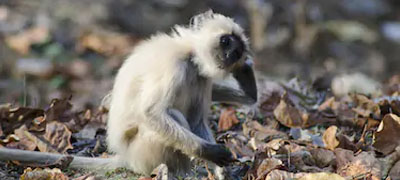 Also known as hanuman monkey, it is a long limbed, long tailed, black faced monkeys, seen as about towns and villages as in forests in India. Langurs are pure vegetarians. They eat wild fruits, flowers, buds, shoots and leaves. They occasional pillage gardens and cultivation, but are not such habitual raiders. The inveterate enemy of langur is the leopard but on the ground they are also attacked by tigers
Also known as hanuman monkey, it is a long limbed, long tailed, black faced monkeys, seen as about towns and villages as in forests in India. Langurs are pure vegetarians. They eat wild fruits, flowers, buds, shoots and leaves. They occasional pillage gardens and cultivation, but are not such habitual raiders. The inveterate enemy of langur is the leopard but on the ground they are also attacked by tigers
Sloth Bear (Melursus Ursinus)
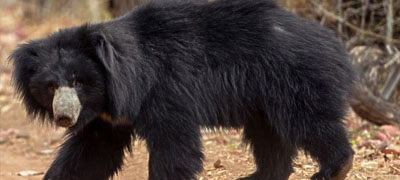 The sloth bear has an elongated muzzle and lower lip, long unkempt hair and short hind legs and is the most untidy of all bears. It comes out shortly before sunset, hunt for food all night and retires in the morning. Their food consists mainly of fruits and insects and they also like honey. Sloth Bear are hunted for their bile, which is considered to have medicinal properties. In Ranthambhore the Sloth Bear is known to chase away the tiger but big male tigers are sometimes able to kill them.
The sloth bear has an elongated muzzle and lower lip, long unkempt hair and short hind legs and is the most untidy of all bears. It comes out shortly before sunset, hunt for food all night and retires in the morning. Their food consists mainly of fruits and insects and they also like honey. Sloth Bear are hunted for their bile, which is considered to have medicinal properties. In Ranthambhore the Sloth Bear is known to chase away the tiger but big male tigers are sometimes able to kill them.
Chinkara of Indian Gazelle (Gazella Bennettii)
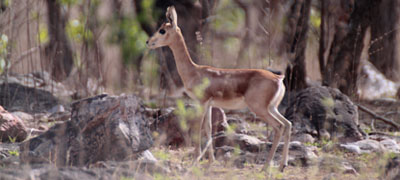 The most delicate and elegant member of the antelope family, the Indian gazelle can go for long periods of time without water and gets its moisture from the dew on the grass and leaves. In Ranthambhore its number are less than 1000 and it is seen infrequently.
The most delicate and elegant member of the antelope family, the Indian gazelle can go for long periods of time without water and gets its moisture from the dew on the grass and leaves. In Ranthambhore its number are less than 1000 and it is seen infrequently.
Leopard (Panthera Pardus)
 Also known as panther, a typical leopard from the Indian peninsula is a sleek, shorthaired animal with a fulvous or bright fulvous coat marked with small close-set black rosettes. The Indian leopard ranges over the whole country. It frequently hunts by day. It will kill and eat anything it can safely overpower: Cattle, dear, monkeys etc. The eopard is often killed for its beautiful coat. I Ranthambhore, it keeps away from the tiger and stickes to the cliffs and escarpments. A good place to watch out for leopards is just before you enter and exit the park on tops of cliff that rise above entrance
Also known as panther, a typical leopard from the Indian peninsula is a sleek, shorthaired animal with a fulvous or bright fulvous coat marked with small close-set black rosettes. The Indian leopard ranges over the whole country. It frequently hunts by day. It will kill and eat anything it can safely overpower: Cattle, dear, monkeys etc. The eopard is often killed for its beautiful coat. I Ranthambhore, it keeps away from the tiger and stickes to the cliffs and escarpments. A good place to watch out for leopards is just before you enter and exit the park on tops of cliff that rise above entrance
Sambar (Cerves Unicolor)
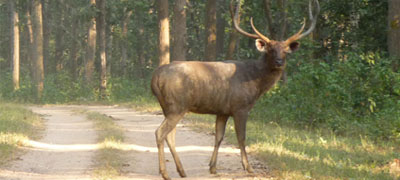 The Sambar is the largest India deer and carries the grandest antlers. Its coat, which is coarse and shaggy, forms a mane about the neck and throat of stags. The general color is brown with yellowish or grayish tinge. Females are lighter in color. They feed mainly at night and their food consists of grass, leaves and various kinds of fruits. Sambar takes to water readily and often swim with the body submerged and only the face and antlers showing above the surface. In anhambhore they number 5000-8000and are one of the most important prey species for the tiger.
The Sambar is the largest India deer and carries the grandest antlers. Its coat, which is coarse and shaggy, forms a mane about the neck and throat of stags. The general color is brown with yellowish or grayish tinge. Females are lighter in color. They feed mainly at night and their food consists of grass, leaves and various kinds of fruits. Sambar takes to water readily and often swim with the body submerged and only the face and antlers showing above the surface. In anhambhore they number 5000-8000and are one of the most important prey species for the tiger.
Wild Boar (Sus Scrofa)
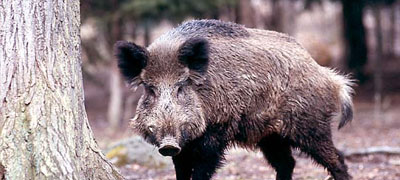 The Indian wild boar has a sparser coat and a fuller crest of black bristles reaching from the nape down the back than other varieties. Newborn wild pigs are born with light or black stripes. They are omnivorous, living on crops, roots, tubers, insects, snakes. They feed early in the morning and late in the evening. Their sense of smell is acute, the eyesight and hearing moderate. The male wild boar has tusks. Good population of wild boar roam Ranthambhore and young piglets are favorite food of tigers and leopards. He tuskers can fight off and even chase a tiger away.
The Indian wild boar has a sparser coat and a fuller crest of black bristles reaching from the nape down the back than other varieties. Newborn wild pigs are born with light or black stripes. They are omnivorous, living on crops, roots, tubers, insects, snakes. They feed early in the morning and late in the evening. Their sense of smell is acute, the eyesight and hearing moderate. The male wild boar has tusks. Good population of wild boar roam Ranthambhore and young piglets are favorite food of tigers and leopards. He tuskers can fight off and even chase a tiger away.
Caracal (Felis Caracal)
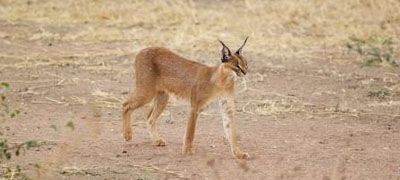 One of the rarest species of cat family to be found in India. Ranthambhore is probably one of the best places to see it if you are lucky. Its about double the size of the jungle cat and can attack baby deer and anything small that moves. A tuft of hair on the tips of its ears makes it distinctive
One of the rarest species of cat family to be found in India. Ranthambhore is probably one of the best places to see it if you are lucky. Its about double the size of the jungle cat and can attack baby deer and anything small that moves. A tuft of hair on the tips of its ears makes it distinctive
Chital (Axis Axis)
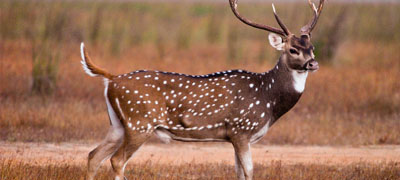 The Chital are also known as spotted deer because of the spots found on its skin. Its coat is bright rufous-fawn profusely spotted with white. They are usually seen in herds of ten to thirty, which may contain two or three stags. They feed till late in the morning and again in the afternoon. In Ranthambhore they number more than 10000 and are critical prey species for the tiger.
The Chital are also known as spotted deer because of the spots found on its skin. Its coat is bright rufous-fawn profusely spotted with white. They are usually seen in herds of ten to thirty, which may contain two or three stags. They feed till late in the morning and again in the afternoon. In Ranthambhore they number more than 10000 and are critical prey species for the tiger.
Jackal (Canis Aureus)
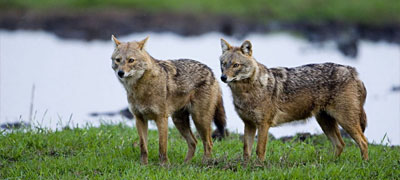 The jackal long drawn, eerie howling at dusk or just before dawn is perhaps more familiar to most people than animal itself. The color of the coat varies with season and locality. Typically, it is a mixture of black and white washed with buff around the shoulders, ears and legs. Jackals usually come out at dusk and retire at dawn. They do good work in clearance of carcasses and offal.
The jackal long drawn, eerie howling at dusk or just before dawn is perhaps more familiar to most people than animal itself. The color of the coat varies with season and locality. Typically, it is a mixture of black and white washed with buff around the shoulders, ears and legs. Jackals usually come out at dusk and retire at dawn. They do good work in clearance of carcasses and offal.
Jungle Cat (Felis Chaus)
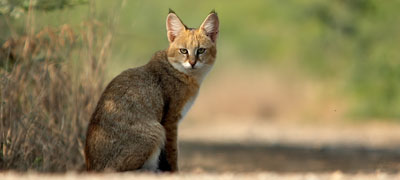 It is the size of a domestic act and lives on rodents and birds. It is quite common in Ranthambhore but you need to peel away the larger shapes and try and find it behind a bush or at the edge of a grassy verge.
It is the size of a domestic act and lives on rodents and birds. It is quite common in Ranthambhore but you need to peel away the larger shapes and try and find it behind a bush or at the edge of a grassy verge.
Nilgai (Boselaphus Tragocamelus)
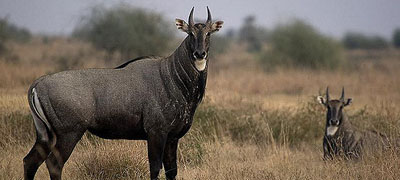 The Nilgai is th largest antilope found in India. It is also known as blue bull because when sunlight falls on the grey coat of male nilgai it gives it a tinge of blue color. It is a great ungainly animal, somewhat horse like in build, with high withers and a low rump. They feed till late in the morning and then again early in the evening. They have the habit of resoting to the same spot to deposit their droppings, forming in this way considerable accumulations. They are found in lesser numbers than sambar or chital in Ranthambhore and frequent the open grassy examples.
The Nilgai is th largest antilope found in India. It is also known as blue bull because when sunlight falls on the grey coat of male nilgai it gives it a tinge of blue color. It is a great ungainly animal, somewhat horse like in build, with high withers and a low rump. They feed till late in the morning and then again early in the evening. They have the habit of resoting to the same spot to deposit their droppings, forming in this way considerable accumulations. They are found in lesser numbers than sambar or chital in Ranthambhore and frequent the open grassy examples.
Crocodile (Crocodylus Palustris)
 The shape of the body follows the generalized reptilian pattern of long body with short limbs. The skin of the back and tail is armoured with bony plates. Crocodilians teeth are shed and replaced every year. Their sense of sight, smell and hearing are well developed. It inhabits rivers, lakes and other large water bodies in the plains and up to 600m in the hills throughout the Indian subcontinent. It is an excellent swimmer. On land, it rests on its belly, but walks and runs with the body well off the ground. It hunts more or less exclusively in water.
The shape of the body follows the generalized reptilian pattern of long body with short limbs. The skin of the back and tail is armoured with bony plates. Crocodilians teeth are shed and replaced every year. Their sense of sight, smell and hearing are well developed. It inhabits rivers, lakes and other large water bodies in the plains and up to 600m in the hills throughout the Indian subcontinent. It is an excellent swimmer. On land, it rests on its belly, but walks and runs with the body well off the ground. It hunts more or less exclusively in water.